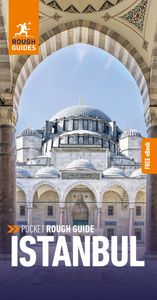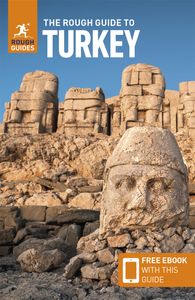The border with Georgia
The 540km Black Sea coastal highway continues for a final 20km beyond the industrial port of Hopa, which holds a limited selection of decent accommodation, to the Turkish–Georgian frontier. Set by the Turkish and Soviet revolutionary governments in 1921, the crossing was virtually inactive between 1935 and 1988, a casualty of Stalinist, then Cold War, paranoia. Since the gates have opened, and especially since a 2011 agreement that allows Georgian and Turkish citizens to cross passport-free, it has become a busy 24-hour way-station. The Turkish border post is in a modern building, with a bank, insurance counter and a small café-restaurant. Minibuses on either side transport passengers to Hopa and beyond (Turkey), or Batumi and Tbilisi (Georgia).
East of Samsun: the coast to Trabzon
Just east of Samsun, the Black Sea coastal plain, watered by the Yeşilırmak delta, widens to its broadest extent. The area was once thought to be the land of the Amazons, a mythical tribe of women who cauterized their right breasts to facilitate spear-throwing and arrow-shooting, and who only coupled with men – their neighbours the Gagarians – during two months of the year, sending male babies to the Gagarians to rear. Nowadays the delta is home to rather more conventional Black Sea Muslims, who are welcoming enough to members of either sex.
Thanks to a new series of tunnels, the main highway heads well inland, through an especially fertile stretch of Turkey’s interior, and thus bypasses the deathly slow coastal road.
Giresun
Founded in the second century BC by the Pontic king Pharnaces, GİRESUN is among the most pleasant stops between Samsun and Trabzon. With an imposing hillside location and a main street that strides straight upwards instead of shadowing the coastline, the town centre is narrower than others, and offers a welcome respite from the noise and pollution of the coastal highway.
Ünye
A small, friendly place, just over 100km east of Samsun, ÜNYE, the ancient Oinaion, makes a thoroughly pleasant overnight stay. It still holds a few grand buildings that date from Byzantine times and its eighteenth-century heyday as a regional port, including a former Byzantine church on the main square, Cumhuriyet Meydanı, that now serves as the Soysal Eski Hamam (daily 5am–midnight: women only Mon–Sat 11am–5pm; men only all other times).
The seafront is home to a leafy park, a pedalo hire station, and a pier that was built for leisure rather than commerce or fishing, a rarity in these climes. If possible, time your visit for the burgeoning Wednesday market, where gold-toothed farm women sell hazelnuts (harvested in August) and unusual edible plants (described under the catch-all term of salata), alongside churns full of milk and cheese.
Lazland
When you pass what was once the eastern limit of the Trapezuntine Empire, around 35km east of Rize, you enter the territory of the Laz, the Black Sea’s most celebrated minority group. While Turks often use the term “Laz” as a catch-all description of all residents of the country’s eastern Black Sea coastline, strictly speaking the Laz themselves are a distinctively Caucasian people who speak a language related to Georgian, 150,000 of whom inhabit Pazar, Ardeşen, Fındıklı, Arhavi and Hopa, plus certain inland enclaves. The men, with their aquiline features and often reddish hair, particularly stand out; they also distinguish themselves by an extroversion unusual even for the Black Sea, and an extraordinary business acumen. Laz own and operate a sizeable chunk of Turkey’s shipping, and the resultant worldly exposure has made them relatively modern in outlook; the women are out and about in Western garb from Fındıklı east, and the men, too, seem better dressed in the latest styles.
It seems likely that the Laz are descended from the ancient Colchians (from whom Jason supposedly stole the Golden Fleece). The Laz accepted Christianity in the sixth century and almost immediately got embroiled in protracted wars with the Byzantines, whose governors had managed to offend them. No power managed fully to subdue them until the Ottomans induced conversion to Islam early in the sixteenth century. Like their neighbours the Hemşinli, they generally practise their faith without the dour piety of some of their countrymen, though they are now well integrated into the national fabric.
Perhaps too well integrated – Lazuri, the spoken language, is under threat, as until recently no systematic transcription system existed. The Turkish authorities have strongly discouraged any attempts to study the language in situ. Despite being declared persona non grata, German linguist Wolfgang Feurstein finally compiled the first Turkish–Lazuri dictionary, complete with a specially devised alphabet, in 1999.
The monastery of Sumela
At the start of the Byzantine era, a large number of monasteries sprang up in the mountains behind Trabzon. The most important and prestigious – and today the best preserved – was Sumela (increasingly signposted as Sümela), which clings to a cliff-face nearly a thousand feet above the Altındere valley, 46km south of Trabzon, in precisely the sort of setting that has always appealed to Greek Orthodox monasticism. Despite the usual crowds, often rainy or misty weather, and the rather battered condition of its frescoes, Sumela still rates as one of the mandatory excursions along the Black Sea.
If you don’t have your own vehicle, you can make the hour-long journey to Sumela from Trabzon by taxi or on a tour. However you arrive, aim to spend at least three hours at the site, allowing for a good look around and a spot of lunch by the rapids which flow through the valley below. The monastery itself is linked to the valley floor by a newly paved road, as well as a commonly used, recently widened and often slippery woodland trail (30min).
Brief history
The name “Sumela” is a Pontic Greek shortening and corruption of Panayia tou Melas or “Virgin of the Black (Rock)”. She has been venerated on this site since at least 385 AD, when the Athenian monk Barnabas, acting on a revelation from the Mother of God, discovered an icon here said to have been painted by St Luke. He and his nephew Sophronios found the holy relic on a site that matched the one in his vision – a cave on a narrow ledge, partway up the all-but-sheer palisade – and installed it in a shrine inside.
A monastery supposedly grew around the image as early as the sixth century, but most of what’s visible today dates from the thirteenth and fourteenth centuries. Over the centuries the icon was held responsible for countless miracles, and the institution that housed it shared its reputation, prompting even Turkish sultans to make pilgrimages and leave offerings.
Six years after Sumela was hastily evacuated in 1923, along with all other Greek Orthodox foundations in the Pontus, it was gutted by fire, possibly started by careless squatters. In 1931 one of the monks returned secretly and exhumed various treasures, including the revered icon of the Virgin, now housed in the new monastery of Sumela, in northern Greece. Since 1996, the monastery has been undergoing restoration. The work done thus far is in reasonable taste, extending to proper ceramic canal-tiles for the roof. Most important of all, the surviving frescoes have been consolidated and cleaned.
Tea
Thanks to a climate that’s perfectly suited to its cultivation, tea is king east of Trabzon. The tightly trimmed bushes are planted everywhere between sea level and about 600m, to the exclusion of almost all other crops. As picking the tender leaves is considered women’s work, during the six warmer months women can be seen humping enormous loads of leaves in back-strap baskets to the nearest consolidation station. Each year, nearly a million raw tonnes of tea is sent more or less immediately to the cutting, fermenting and drying plants whose stacks are recurring regional landmarks.
Oddly enough, tea is a very recent introduction to the Black Sea, the pet project of one Asim Zihni Derin, who imported the first plants just before World War II to a region left badly depressed following the departure of its substantial Christian population in 1923. Within a decade or so, tea became the mainstay of the local economy, overseen by Çaykur, the state tea monopoly. Despite the emergence of private competitors since 1985, and the Chernobyl accident, which spread radiation over the 1986 crop, Çaykur is still a major player in the domestic market. Export, however, seems unlikely, as supply can barely keep pace with domestic demand.
The Hemşin valleys
The most scenic and interesting of the foothill regions east of Trabzon are the valleys of the Fırtına Çayı and its tributaries, which tumble off the steepest slopes of the Pontic ranges, here known as the Kaçkar Dağları. Between the mountains and the sea lie a few hundred square kilometres of rugged, isolated territory known simply as Hemşin.
A short trek: Pokut and Amlakit
If your level of commitment isn’t up to multi-day treks that require you to camp out in the high mountains, consider the track that heads southeast from Şenyuva, a typically dispersed community of occasionally impressive farmstead dwellings 6–8km above Çamlıhemşin. The best accommodation here is at Fırtına Pansiyon.
Beyond Şenyuva, the route is blocked by snow for much of the year, so it’s only advisable during high summer. Pokut, a 3hr walk from Şenyuva via Sal, is fairly representative of the more substantial Black Sea yaylas, with handsome woodwork capped by mixed tin-and-timber roofs rising from stone foundations. For the first night’s lodging, try Poket Yaylasi.
The following day you hike east to Hazindag (Hazıntak), a handsomely clustered settlement just above the tree line, then briefly follow a majestic river canyon on a corniche route south before veering up and southeast to the primitive rock-and-sod cottages of Samistal. Weather permitting, the ridge above Samistal offers spectacular views of the main Kaçkar summit ridge. You then double back west to Amlakit, with its Pansiyon, or drop in stiff zigzags from Samistal to Aşağı Kavron, which is linked by minibuses to Ayder.
If you stay in Amlakit, a final day of walking would see you use a direct trail north to Hazindag and thence back to Pokut and Sal (there’s a steep path northeast through cloud forest direct to Ayder, but it’s presently in bad condition). Alternatively, keener trekkers can carry on south from Amlakit for 45min on a rough road to Palovit (2300m), and thence to Apevanak Yayla (2500m) en route to the true alpine zone.
The Hemşinlis and yaylas
With their fair skin and strong features, the people of the Hemşin valleys, known as the Hemşinlis, tend to look more Caucasian than Turkish. According to competing theories, these outgoing, gregarious people are either ethnic Armenians who arrived here at or before the time of the Georgian kingdoms, or natives descended from the Heptacomete tribesmen of old, who, through contact with “true” Armenians, adopted a dialect of Armenian and were nominally Christian or pagan until the early nineteenth century. Although most Hemşinlis are now Muslim, they wear their religion lightly: you’re unlikely to be blasted out of bed at dawn by a muezzin around here, and, despite stern little signs in local shops warning that “alcohol is the mother of all ills”, the men in fact are prodigious drinkers. This tendency is aggravated by the environment. This is by far the dampest and mistiest part of Turkey, with the sun in hiding two days out of three and up to 500cm annually of rain in some spots. The result is cloud-forest vegetation, with everything from moss-fringed fir and alders down to marsh species and creeping vines clinging to the slopes.
Hemşinlis are renowned for being intrepid and independent. They also have a special genius for the profession of pastry chef and pudding-maker: the top sweet shops (pastanes) of major Turkish cities are usually owned and/or staffed by natives of these valleys. But to fully understand the Hemşin mentality you need to visit at least one yayla, or summer pastoral hamlet.
Yaylas are found in the uplands throughout Turkey, but in the Kaçkar in general – and especially Hemşin – they’re at their best. Tightly bunched groups of dwellings, usually stone-built to waist height, and chalet-style in timber thereafter, albeit with metal roofs, they begin just at the tree line and recur at intervals up to 2700m. They’re inhabited only between late May and early September, when the snow recedes. Their tenants come from as far away as Holland or Germany to renew attachments to what they consider their true spiritual homeland. Traditional summer activities include making yoghurt, butter and cheese, and (increasingly) catering to trekkers’ needs.






















